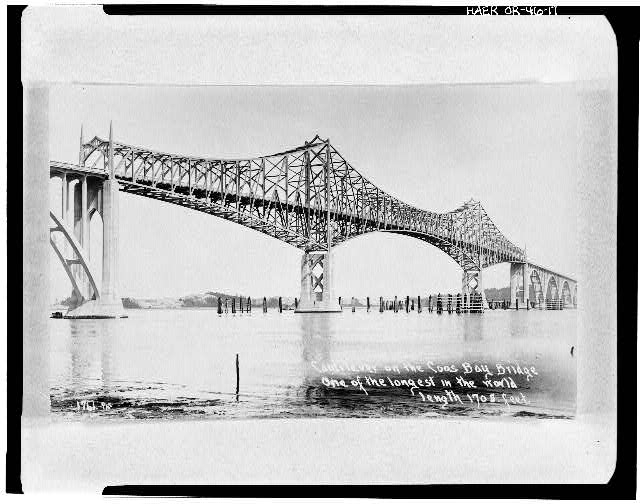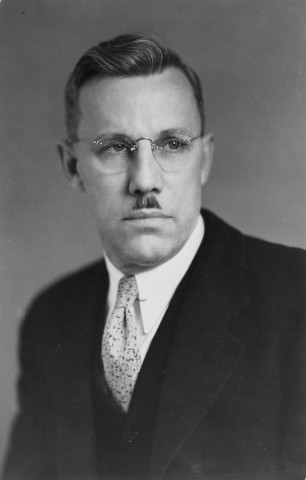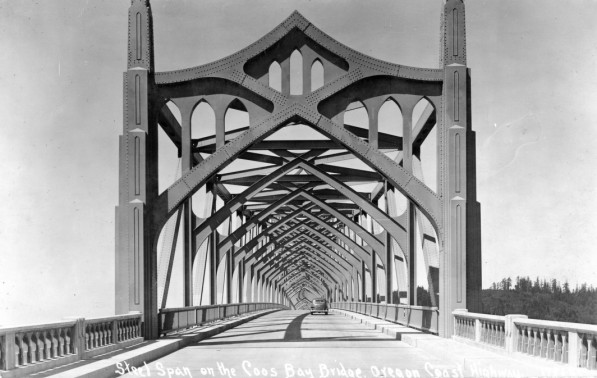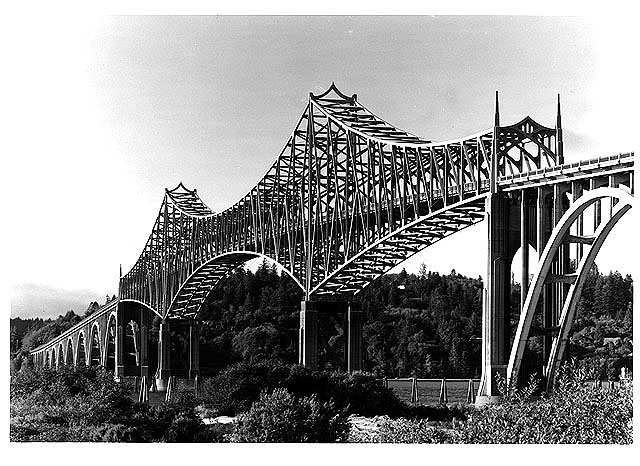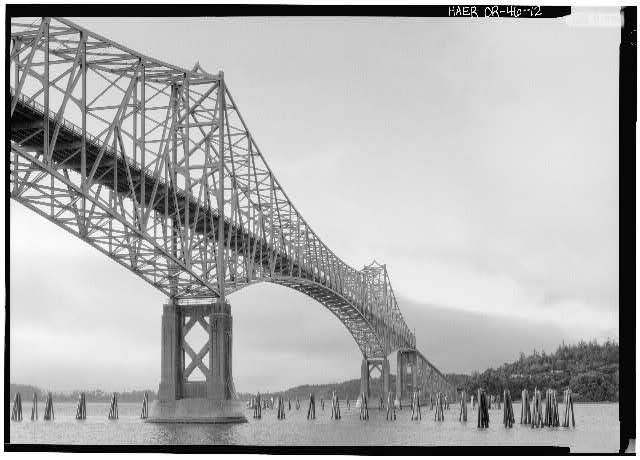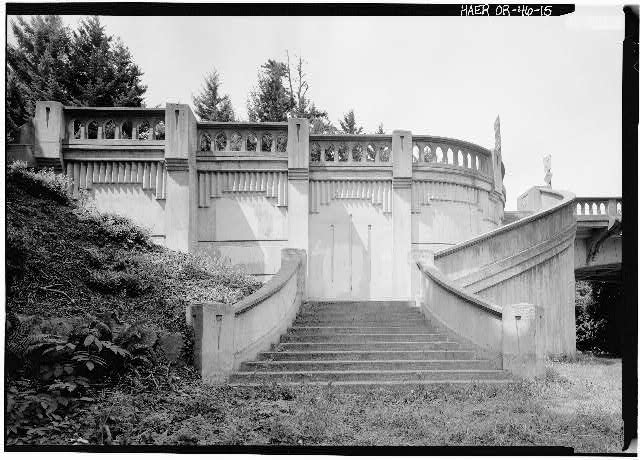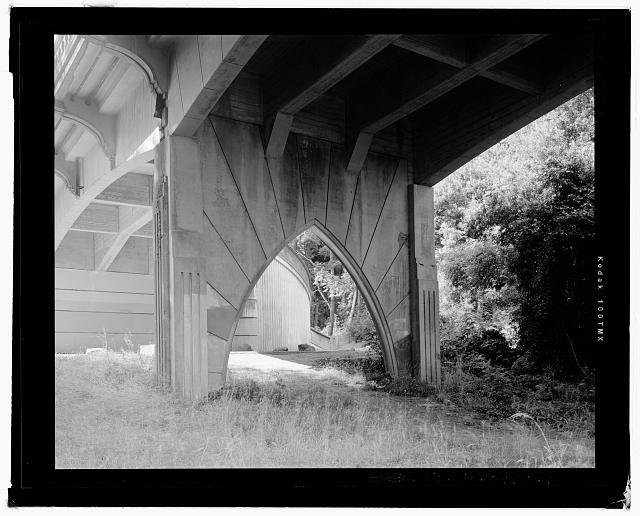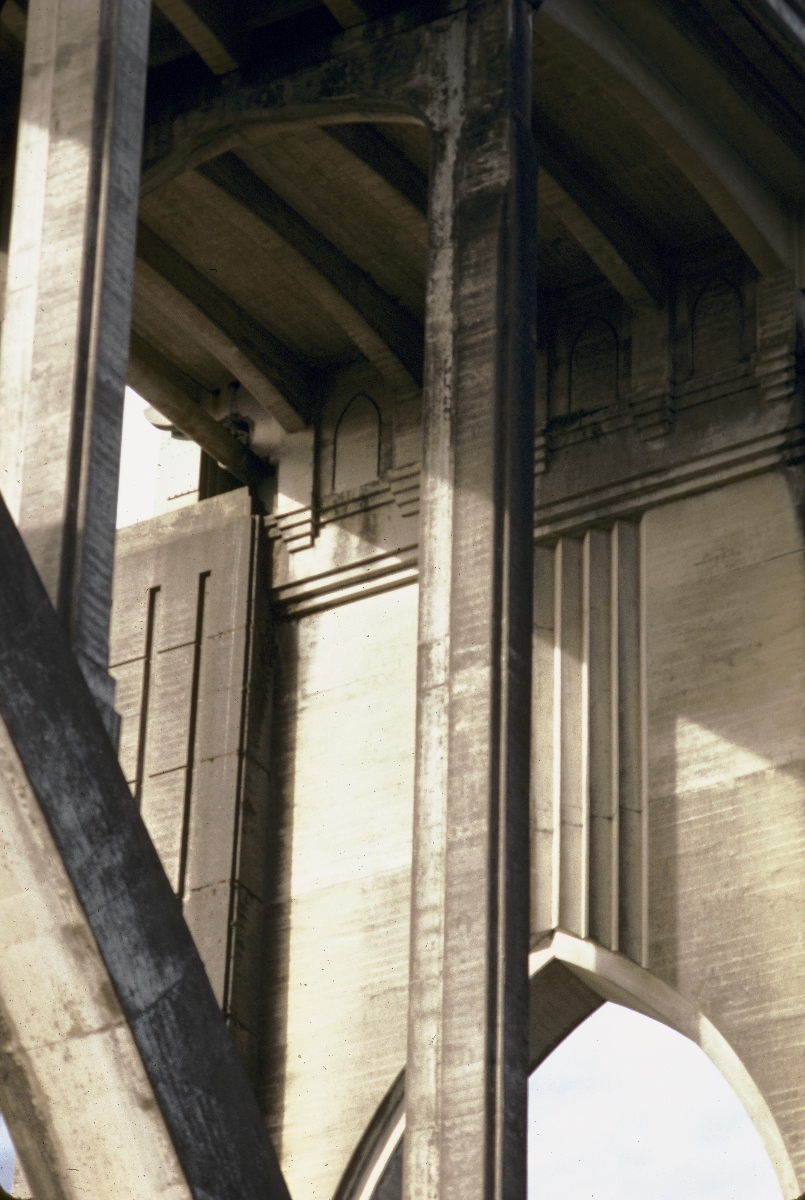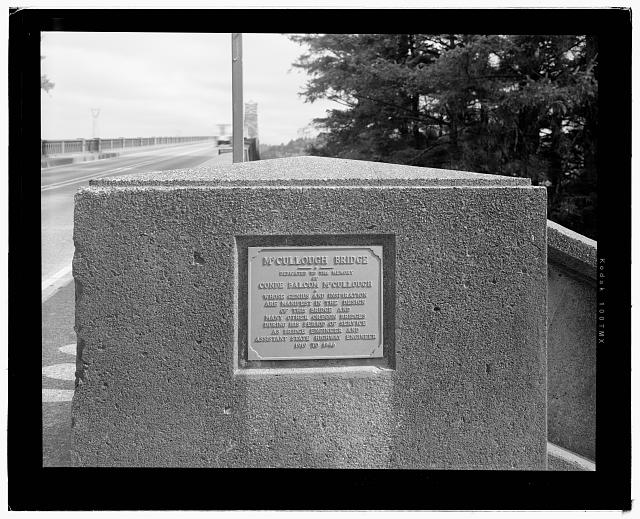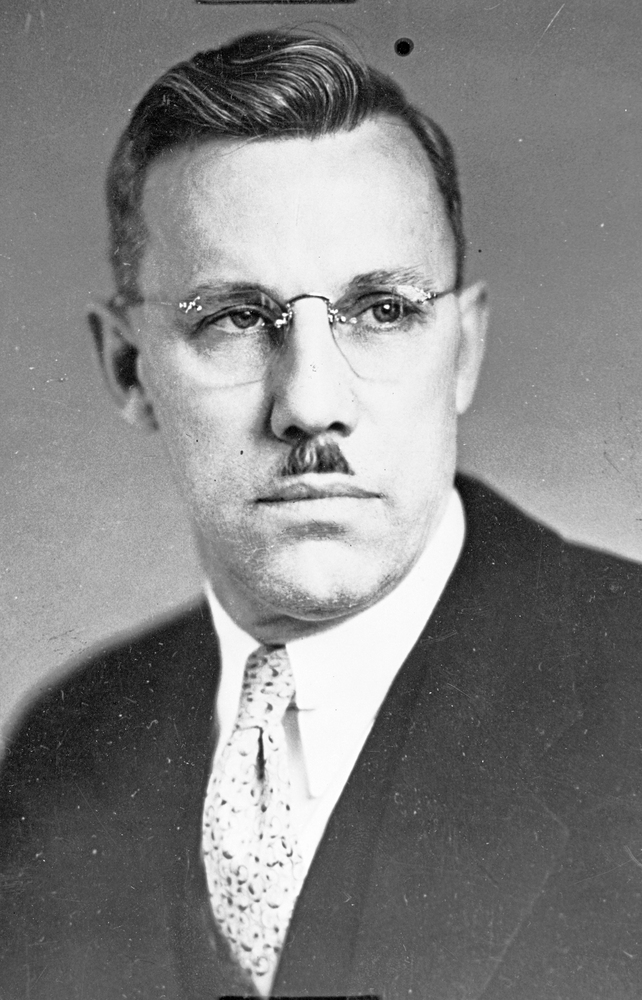Of all the bridges engineer Conde B. McCullough designed, the one on Highway 101 that spans Coos Bay was his favorite. This impressive bridge was renamed the Conde B. McCullough Memorial Bridge in 1947, the year after McCullough died. The bridge was part of the federally funded Coast Bridges Project, a Works Progress Administration (WPA) plan in 1934-1936 to build five bridges across coastal waterways in order to complete the Oregon Coast Highway. With its mix of Art Deco, Gothic, and Moderne design elements, the McCullough Memorial is one of the most recognizable icons of the Oregon coast.
Originally called the Coos Bay Bridge, at 5,305 feet it was the longest in the state highway system when it was completed in 1936. Because the 793-foot-wide navigation channel had to remain open during construction, McCullough designed a steel cantilevered truss mid-section, with the road deck reaching 150 feet above water. Temporary work bridges were built out to the piers where each cantilever section began. This provided access as well as a base to build temporary supports, as the arms of the cantilever sections extended over the work bridges. Although the construction resembled a giant erector set, the building of the 1,708-foot steel truss was considered an engineering triumph for its time. The steel truss is flanked on each side by several reinforced-concrete arches below the road deck, leading to entry plazas boasting elaborately embellished abutments and staircases.
The technical challenges McCullough faced constructing the mile-long bridge over a busy water channel, complete with pedestrian walkways and wide staircases, made the then-Coos Bay Bridge the most difficult of the coast bridges to build. About 250 men were employed to work on the bridge at any one time, moving over 24,000 cubic yards of soil, over 48,000 cubic yards of concrete, nearly 12 million pounds of steel, and 5 million board feet of lumber—most of which came from local timber companies. As a result of the influx of jobs and the need for natural resources such as lumber, the economic benefit of the Coast Bridges Project to Oregon communities suffering from the Depression was significant.
The bridge was dedicated on June 5-7, 1936, with a parade, music, banquets, and fireworks. In December 1986, a ship damaged the bridge’s understructure, causing a six-week bridge closure. Those who needed to cross Coos Bay suddenly realized the bridge’s significance, as a trip of a few minutes now took almost an hour. The Conde B. McCullough Memorial Bridge was entered into the National Register of Historic Places in 2005.
-
![Coos Bay Bridge, c. 1936]()
Coos Bay Bridge, c. 1936.
Coos Bay Bridge, c. 1936 Courtesy Library of Congress, HAER ORE, 6-NOBE, 1-17
-
![Conde B. McCullough]()
Conde B. McCullough .
Conde B. McCullough Courtesy Oregon State University Archives, P17:451
-
![Coos Bay Bridge, steel span, c. 1936]()
Coos Bay Bridge, steel span, c. 1936.
Coos Bay Bridge, steel span, c. 1936 Courtesy Library of Congress, HAER ORE,6-NOBE, 1-17
-
![Conde B. McCullough Memorial Bridge]()
Conde B. McCullough Memorial Bridge.
Conde B. McCullough Memorial Bridge Courtesy Library of Congress, photo by Jet Lowe, 1990, HAER ORE,6-NOBE, 1-10
-
![Conde B. McCullough Memorial Bridge]()
Conde B. McCullough Memorial Bridge.
Conde B. McCullough Memorial Bridge Courtesy Library of Congress, photo by Jet Lowe, 1990, HAER ORE,6-NOBE, 1-12
-
![Stairway at south abutment]()
Stairway at south abutment.
Stairway at south abutment Courtesy Library of Congress, photo by Jet Lowe, 1990, HAER ORE,6-NOBE, 1-15
-
![Conde B. McCullough Memorial Bridge]()
Conde B. McCullough Memorial Bridge.
Conde B. McCullough Memorial Bridge Courtesy Library of Congress, photo by Jet Lowe, 1990, HAER ORE,6-NOBE,1-33
-
![Conde B. McCullough Memorial Bridge]()
Conde B. McCullough Memorial Bridge.
Conde B. McCullough Memorial Bridge Courtesy University of Oregon Libraries, photo by Michael Shellenbarger, 1985
-
![Dedication to McCullough]()
Dedication to McCullough.
Dedication to McCullough Courtesy Library of Congress, photo by Jet Lowe, 1990, HAER ORE,6-NOBE, 1-32
Related Entries
-
![Conde Balcom McCullough (1887-1946)]()
Conde Balcom McCullough (1887-1946)
Conde B. McCullough, born in Dakota Territory in 1887, was raised and e…
-
![Coos Bay]()
Coos Bay
The Coos Bay estuary is a semi-enclosed, elongated series of sloughs an…
-
![US 101 (Oregon Coast Highway)]()
US 101 (Oregon Coast Highway)
Many places on the Oregon coast were virtually inaccessible in the earl…
Map This on the Oregon History WayFinder
The Oregon History Wayfinder is an interactive map that identifies significant places, people, and events in Oregon history.
Further Reading
Fleagle, Judy and Richard K. Smith. Crossings: McCullough's Coastal Bridges. Florence, Ore.: Pacific Publishing, 2011.
Hadlow, Robert W. Elegant Arches, Soaring Spans, C.B. McCullough, Oregon’s Master Bridge Builder. Corvallis: Oregon State University Press, 2001.
Smith, Dwight A, James B. Norman, and Pieter T. Dykman. Historic Highway Bridges of Oregon. Portland: Oregon Historical Society Press, 1989.

